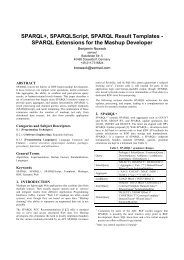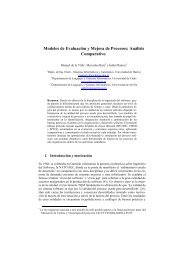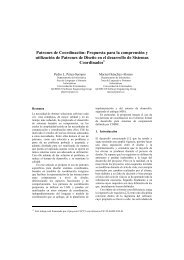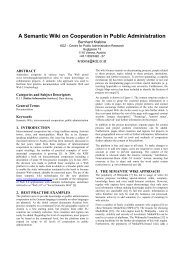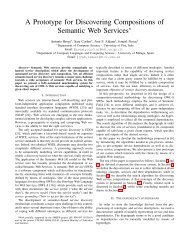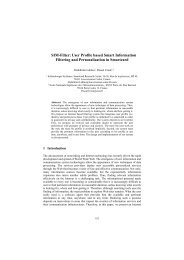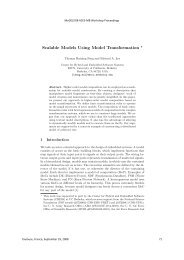ontology-based information extraction systems (obies 2008)
ontology-based information extraction systems (obies 2008)
ontology-based information extraction systems (obies 2008)
Create successful ePaper yourself
Turn your PDF publications into a flip-book with our unique Google optimized e-Paper software.
Table 1 Results of the Relation Validation Task<br />
Systems kill relation birthplace relation<br />
BoW (Baseline1) 72.0% 75.0%<br />
Triple (Baseline2) 70.3% 76.4%<br />
Main + Backups 84.1% 86.5%<br />
As we described in 2.1, the RTE system consists of a main approach plus two<br />
backup strategies. We take the two backup strategies as two baseline <strong>systems</strong> for<br />
comparison.<br />
3.2. The Experiment on Web Data<br />
To further test our ReVaS system, we have integrated it into an existing unsupervised<br />
IE system IDEX developed in our lab (Eichler et al., <strong>2008</strong>). If a topic (in form of<br />
keywords) is given to IDEX, it will use it as a query to a search engine on the World<br />
Wide Web. The retrieved documents will be analyzed using a dependency parser and<br />
an NE recognizer. The relations of NEs are identified via locating NEs in the<br />
dependency parse tree and finding the common parent node, which is normally a verb.<br />
The extracted instances of relations will be further clustered into different relation<br />
groups.<br />
We have collected in all 2674 instances of binary relations from the IDEX system,<br />
including various relation types. The following table gives out some examples,<br />
Table 2 Output examples of the IDEX system<br />
Relation NE1 NE2<br />
located Berlin Germany<br />
working Tricon Bangkok<br />
say Britons Slovakians<br />
… … …<br />
Being different from the annotated data set, these instances of relations returned by<br />
IDEX are all positive examples for the system. However, even with the clustering, it<br />
is not trivial to identify the names of relation types. To make full use of the data, we<br />
hypothesize a relation type first and then check each instance whether it is of this<br />
relation type. Therefore, instances consistent with this relation type are positive cases<br />
(as a gold standard here), and all the other instances are negative ones.<br />
The evaluation metrics we have applied are precision and relative recall (Frické,<br />
1998). The reason for using relative recall instead of normal recall is that we do not<br />
know how many instances of one particular relation we can find from the web. Thus,<br />
we take one setting of our system as a reference (i.e. its recall is assumed as 1.0) and<br />
other settings’ recalls will be compared to it. The precision is more interesting to us in<br />
this validation task, since it tells us how accurate the system is.<br />
Two aspects we want to analyze <strong>based</strong> on the experiments, i.e. directionality and<br />
strictness.<br />
A relation is said to be directional if the action of that relation is from one NE to<br />
the other, i.e. the NE pair is asymmetric; a relation is non-directional if the pair is<br />
symmetric. As we know, some relations containing two NEs with the same type are



